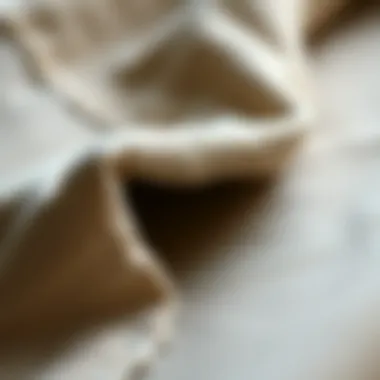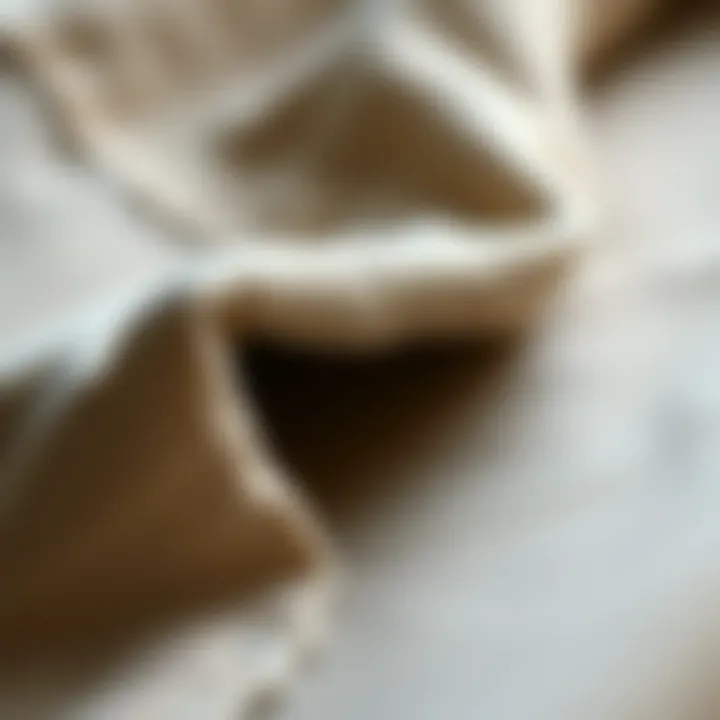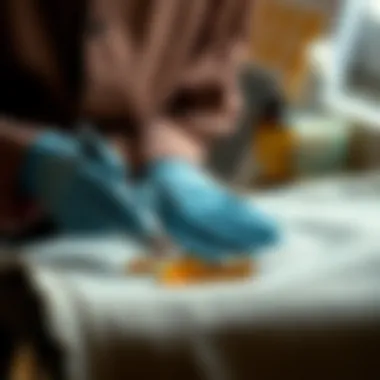Fortifying Wax in Fabric Care and Fashion: An In-Depth Look


Intro
The world of fashion and fabric care is evolving at a pace faster than many can keep up with. Among the myriad products vying for attention in this bustling industry, fortifying wax stands out as an unsung hero. With its ability to enhance the durability, appearance, and function of fabrics, this wax offers considerable advantages that many may not yet fully appreciate. In our examination, we will explore not only its practical applications but also the science behind it—all while considering the environmental implications.
Fortifying wax isn't just for high-end textiles; it's finding its way into everyday garments too. Imagine prolonging the life of your favorite jacket or ensuring that your stylish umbrella withstands unpredictable weather. This article will dissect these applications, pin down some maintenance tips, and shed light on greener alternatives worthy of consideration. As we traverse this topic, we will also examine fashion trends and how they integrate with sustainable practices, making for a comprehensive guide to fabric care in a modern context.
Ultimately, our mission is to reveal how fortifying wax not only plays a crucial role in preserving fabrics but also aligns with a broader commitment to sustainability within the fashion industry. Let’s embark on this journey to discover the multifaceted role that fortifying wax plays, ensuring that your wardrobe remains as fresh as the day you purchased it.
Understanding Fortifying Wax
Fortifying wax plays a significant role in the realm of fabric care and fashion, functioning as a protector, enhancer, and sustainable option within the textile industry. To fully grasp its importance, one must consider both its definition and its historical context. Understanding these elements can shed light on how fortifying wax achieves its multifaceted benefits, which include fabric longevity, appearance enhancement, and environmental friendliness. The increasing awareness of sustainability among consumers makes this topic particularly relevant today.
Definition of Fortifying Wax
Fortifying wax refers to a specialized formulation designed to reinforce the durability and practicality of various fabrics. This wax is generally made from natural ingredients like beeswax or carnauba wax, and synthetic components, depending on the desired properties. Its primary functions include adding a protective layer to fabric surfaces, enhancing the visual appeal of the material, and promoting ease of care.
When applied, fortifying wax can increase water resistance and improve the overall strength of the fabric structure. It is no surprise that many fashion designers, textile producers, and fabric care enthusiasts embrace this product in their work and daily routines. Its wide-ranging uses in everything from outdoor apparel to upholstery make it a go-to choice for those looking to marry functionality with style.
Historical Context
The use of wax in textile treatments is not a contemporary development. In fact, it traces back several centuries when artisans employed natural waxes to preserve and enhance the resilience of materials. Whether it was for coats, tents, or everyday garments, the application of wax served as an effective way to combat the elements.
Historically, the knowledge of wax application was passed down through generations, often within specific communities that relied on these techniques for survival against various environmental challenges. For example, indigenous peoples across the globe have utilized waxes derived from local flora and fauna in their traditional garments, ensuring that they remain functional in harsh climates.
As the industrial revolution kicked off, new wax formulations began to emerge, enabling larger scale production and a broader application of fortifying wax in fabric care. Today, with the revival of interest in sustainable fashion, historical practices have found renewed significance, as modern designers and consumers seek eco-friendly alternatives to synthetic treatments. This interplay between past and present enhances the allure of fortifying wax, showcasing its enduring relevance.
Fortifying wax is notably beneficial, combining the wisdom of traditional practices with innovative solutions for modern fabric care.
Composition of Fortifying Wax
Understanding the composition of fortifying wax is crucial as it plays a significant role in its effectiveness for fabric care and fashion. Enhancing fabric resilience, preserving aesthetic appeal, and ensuring protection against various environmental factors all hinge on the ingredients used in wax formulations. Moreover, the unique characteristics of each component can contribute to not just the performance but also the sustainability of the products.
Ingredients and Their Functions
Fortifying wax is typically crafted from a blend of natural and synthetic elements, each chosen for their specific properties. Here are some key ingredients found in many formulations:
- Beeswax: Known for its exceptional emollient and moisturizing properties, beeswax is a natural wax that forms a protective barrier over fabrics. It helps in retaining moisture, thus reducing fabric brittleness and wear over time.
- Carnauba Wax: Often dubbed the ‘queen of waxes’, carnauba wax is sourced from the leaves of the Brazilian palm tree. It provides a glossy finish while enhancing water resistance, making it ideal for outdoor apparel.
- Paraffin Wax: This petroleum-based wax is widely used due to its cost-effectiveness and versatility. Its main function lies in creating a water-repellent surface, although it lacks the bio-degradability of natural waxes.
- Microcrystalline Wax: This wax lends flexibility and a soft feel to fabrics. It's often combined with other waxes to improve the overall texture and durability of the final product.
- Oil and Resins: These additives can enhance the adhesion and spreadability of the wax, ensuring a more uniform application to the fabric surface.
Each ingredient brings a unique contribution to the composition, and the interplay among them defines the performance of the final product.
Variations of Wax Formulations
When it comes to wax formulations, there is no one-size-fits-all. Several variations exist to cater to different fabric types and specific use-cases:
- Natural Wax Formulation: Ideal for eco-conscious consumers, these formulations utilize only natural waxes like beeswax and plant-derived ingredients. They offer a sustainable alternative while providing adequate protection and nourishment to fabrics.
- Hybrid Waxes: These combine both natural and synthetic components, often selected to capitalize on the strengths of each. For example, a hybrid formulation can offer the renewable attributes of natural wax alongside the durability of synthetic wax.
- Performance Waxes: Tailored specifically for technical clothing, such as outdoor gear or sportswear, these formulations often prioritize water and stain resistance along with flexibility, ensuring that the fabrics can withstand harsh conditions without compromising style.
- Finishing Waxes: Used mainly in the final stages of fabric production, these waxes impart a specific feel or finish to the fabric. They enhance luster, softness, and overall aesthetic quality of the textiles, making them more appealing to consumers.
Recognizing the various formulations helps not only in choosing the right product but also in understanding its potential impact on both performance and environmental sustainability.
The composition of fortifying wax is not just about safeguarding fabrics; it involves balancing efficacy with ecological sustainability.
Applications in Fashion
In the realm of fashion, fortifying wax holds a pivotal role that transcends mere cosmetic enhancement, offering substantial benefits not just for the fabric but also for the wearer. Its applications stretch from the practical, such as protecting garments from wear and tear, to the aesthetic, wielding influence over the appearance and style of fabrics. This section delves into the diverse roles that fortifying wax plays in the fashion industry, focusing on specific elements, benefits, and considerations that make its use both essential and advantageous.
Role in Fabric Protection
The protective properties of fortifying wax cannot be overstated. When applied correctly, it acts as a barrier against a range of damaging factors. For instance, this protective layer can help fabrics resist water and stains, making it particularly useful for items like outdoor gear or everyday clothing that comes into contact with spills and environmental elements.


When you think about clothing that's taken out for a night on the town, visibility often comes into play. For example, a dark wax layer on a fabric can not only provide water resistance but also enhance its durability. If your favorite coat stands tall through winter rain, you’ll see the value in that extra layer. The addition of wax means fewer wash cycles, leading to prolonged fabric life. Furthermore, the wax has the ability to mend minor fabric abrasions. It’s like a band-aid for your clothes, filling in small scratches and saving you from potentially costly repairs.
"Fortifying wax acts like a shield, protecting garments from the everyday rigors of life, ensuring they stay in pristine condition for much longer."
Enhancing Aesthetic Qualities
Beyond protection, fortifying wax serves to enhance the aesthetic qualities of fabrics, which is a game-changer in the fashion world. The application alters how light interacts with the fabric, often leading to a subtle sheen that can elevate the overall look of clothing. This shimmering effect can contribute to a sense of luxury and craftsmanship, altering the garment's appearance to stand out in a sea of fabrics.
Another interesting aspect is the texture transformation. Waxed fabrics often gain a degree of stiffness that helps garments maintain their shape while still looking fabulous. Take, for instance, a waxed canvas jacket—it exudes toughness and style simultaneously. This blend of texture and sheen contributes to a more curated visual aesthetic, appealing particularly to fashion enthusiasts who may prioritize distinctive styles.
Moreover, the tactile quality of wax-treated fabrics invites a sensory experience that goes beyond sight. The feel of a well-treated garment can be just as important as its visual appeal. It’s this mix of texture and shine that makes an outfit not just a utility but a statement.
In summary, fortifying wax in fashion is more than just a practical choice; it is a strategic element that preserves fabric and heightens aesthetic appeal. As such, its use continues to attract the attention of both designers and consumers looking for long-lasting, stylish clothing.
Benefits of Fortifying Wax
Fortifying wax plays a significant role in the realm of fabric care, functioning as a safeguard that extends the life of textiles while enhancing their appearance. This remarkable substance has gained traction among fashion enthusiasts and industry professionals alike due to its multifaceted benefits. By understanding its key advantages, one can better appreciate the importance of fortifying wax in fabric maintenance and care.
Improving Fabric Longevity
One of the most significant benefits of fortifying wax is its ability to improve fabric longevity. This is not merely a matter of keeping clothes looking good; it’s about preserving the structural integrity of the material itself. When applied to fabrics, fortifying wax creates a protective barrier that helps to mitigate the wear and tear caused by everyday use.
For instance, a well-applied wax layer can act like a shield against abrasions that frequently plague items like jackets or workwear. The presence of this wax minimizes the fraying at seams and the fading of colors, meaning that garments remain robust and visually appealing for much longer.
"A good piece of clothing should tell a story, not look like it has been through the wringer. Fortifying wax helps maintain that narrative."
The technique of applying wax requires careful attention. Proper distribution ensures an even coating which ultimately leads to better defense against the elements. By reinforcing the way fabrics endure daily challenges, fortifying wax effectively elongates the life cycle of garments, making a marked impact in reducing waste within the fashion industry.
Water and Stain Resistance
Another standout characteristic of fortifying wax is its contribution to water and stain resistance. When you treat fabrics with wax, they become far less susceptible to moisture absorption and staining. Imagine wearing a beautifully tailored coat that holds its ground against a sudden rain shower or an accidental spill during a dinner date - that’s exactly what fortifying wax offers.
This functionality is especially valued in outdoor garments or items that regularly encounter everyday spills. Waxed fabrics repel liquids, making clean-up easier and reducing the likelihood of lasting damage.
Moreover, water and stain resistance is not merely a luxury; it's a necessity for consumers who prioritize durability along with aesthetics in their wardrobe choices. Fortifying wax achieves this through a transformative process called hydrophobicity, which alters the surface tension of the fabric, ensuring that moisture beads off rather than penetrates.
Promoting Sustainable Fashion
In today’s climate-conscious world, sustainability is no longer a nice-to-have; it's a must-have. Fortifying wax disrupts the otherwise linear consumer patterns by promoting sustainable fashion practices. By significantly extending the life of clothing, it reduces the frequency of replacements, which in turn cuts down on textile waste.
Furthermore, many brands are evolving their formulations to include materials that are eco-friendly and biodegradable, enriching the sustainability narrative. When consumers choose products enriched with fortifying wax, they're not only taking steps towards a more durable wardrobe but also making decisions that have less impact on the environment.
This alignment with green practices makes fortifying wax a valuable element in advocating for a more responsible fashion landscape. By enhancing garment durability through thoughtful care, it encourages consumers to invest in quality over quantity, fostering a culture where longevity is valued.
Application Techniques
Understanding how to effectively apply fortifying wax is paramount in maximizing its benefits for fabric care and ensuring that garments maintain their appearance and durability over time. The technique not only influences the final aesthetic but also significantly impacts the performance of the wax in providing protection against environmental factors such as moisture and dirt.
How to Apply Fortifying Wax
Applying fortifying wax might seem straightforward at first glance, but there are specific steps that one should follow for optimal results. This process ensures even coverage and effective bonding to the fabric fibers. Here’s how it can be done:
- Preparation: Start by selecting a clean fabric surface that you wish to treat with wax. Ensure the item is free of dust and dirt. Washing and drying it beforehand can make a big difference.
- Warm the Wax: If the wax is hard, consider warming it slightly. This makes it easier to spread and soak into the fibers. You can place it near a heat source, but use caution to avoid overheating.
- Application: Using a clean cloth or applicator, take a small amount of wax and rub it into the fabric in circular motions. This allows the wax to penetrate deeper into the fibers. Work in sections to ensure you don’t miss any spots.
- Heat Activation: After applying the wax, use a heat source like a hairdryer or a heat gun at a moderate setting. This step melts the outer layer of wax and helps it fuse into the fabric.
- Cooling and Setting: Allow the treated fabric to cool down completely before using it. This ensures that the wax hardens properly, providing enhanced protection for your fabric.
Best Practices for Application
Applying fortifying wax can be a straightforward task, yet several best practices enhance the process and results, ensuring that your fabrics benefit the most. Consider these recommendations:


- Test on a Small Area: Before full application, test the wax on a hidden part of the fabric. This will help to gauge how the material reacts to the wax and avoid unforeseen discoloration.
- Use Appropriate Tools: A dedicated cloth or brush can improve the application process. Make sure these tools are clean and suitable for wax application to avoid cross-contamination with other substances.
- Layering: Depending on the type of fabric, applying the wax in layers may yield better protection. Allow each layer to dry before applying the next to maximize effectiveness.
- Environmental Considerations: Try to apply the wax in a well-ventilated space, especially if you're using heat. This ensures that any fumes do not accumulate in the area.
- Regular Checks: Periodically check that the wax remains intact and effective, especially after multiple washes or extensive wear. A reapplication may be necessary to maintain the protective qualities.
"Proper application techniques are crucial for maximizing the benefits of fortifying wax, prolonging the lifespan and appearance of fabric items."
By keeping these application techniques in mind, you can ensure that your fabric care regimen with fortifying wax not only enhances the durability and aesthetic appeal of your garments but also contributes positively to sustainability by extending the life of your clothing.
Care and Maintenance of Waxed Fabrics
Understanding the right care and maintenance of waxed fabrics is crucial for maximizing their lifespan and maintaining their aesthetic appeal. Fortifying wax serves as a protective layer, but its effectiveness hinges on how one looks after the fabric. Employing appropriate care techniques can ensure that these materials not only remain in good condition but also retain their original qualities over time.
Washing and Cleaning Guidelines
When it comes to cleaning waxed fabrics, one must tread carefully. Regular washing can diminish the effectiveness of the wax coating if done incorrectly. Here are guidelines to follow:
- Gentle Cycle: Always opt for a gentle cycle when laundering waxed items. The rough and tumble of a regular wash can strip the wax away.
- Cold Water: Use cold water only. Hot water can heat the fabric and melt the wax, leading to uneven surfaces.
- Mild Detergent: Choose a mild detergent. Harsh chemicals can degrade the wax quality, negating the protective qualities it offers.
- Avoid Fabric Softeners: These products can create a barrier on the fabric, interfering with the wax’s ability to repel water and stains.
- Air Dry: After washing, let the fabric air dry; using a tumble dryer can produce heat that damages the wax layer.
"Proper washing is not just about cleanliness; it's about preserving the fabric's functional and aesthetic properties."
Reapplication Timing
Reapplication of fortifying wax is essential to keep the fabric’s protective features intact. However, determining the right time for reapplication is key. Factors to consider include:
- Frequency of Use: If the fabric is frequently worn or exposed to elements, plan for reapplication every few washes.
- Signs of Wear: Look for signs that suggest a waning wax layer, such as water soaking into the fabric or increased stain susceptibility. These are indicators that the protective barrier has diminished.
- Seasonal Changes: Changing weather conditions can affect wax durability. For instance, during rainy seasons or heavy use, more frequent reapplication can be necessary.
- Storage: Just as one must maintain fabrics during use, think about seasonal storage. If storing for winter, ensure the wax is fresh to offer the best defenses against moisture.
Maintaining waxed fabrics requires some attention, but the effort pays off. Investing time in proper care and timely reapplications conserves the advantages that fortifying wax provides.
Considerations for Different Fabrics
When dealing with fortifying wax, the type of fabric is crucial to consider. Each fabric has its own unique properties and care requirements, influencing how effective the wax will be. In this discussion, we will highlight the nuances of applying wax to both natural fibers and synthetic materials. Understanding these distinctions ensures that the protective qualities of the wax are maximized while maintaining the integrity and appearance of the fabric.
Wax on Natural Fibers
Natural fibers, such as cotton, wool, linen, and silk, bring their own charm but also specific challenges when it comes to waxing. First off, natural fabrics are highly breathable, making them comfortable in various conditions. However, they can be more reactive to waxing due to their inherent absorbency.
- Understanding Absorbency: Natural fibers can absorb wax deeply, which can either be a boon or a bane. If too much wax seeps in, it might weight down the fabric or alter its original texture.
- Preserving Aesthetic Qualities: For fabrics like silk or fine cotton, the goal is to enhance their aesthetic without compromising their softness and drape. A carefully applied layer of wax can offer protection while keeping the fabric looking elegant.
- Resistance to Environmental Factors: Wax adds a waterproof barrier against rain or spills, which is particularly beneficial for outdoor garments made from cotton or linen. Just be cautious, as frequent washing can break down this shield, requiring reapplication.
- Temperature Sensitivity: Because natural fibers can be heat-sensitive, it’s important to keep the application temperature moderate. Excessive heat may warp the fabric or alter its colors.
Wax on Synthetic Materials
Synthetic materials like polyester, nylon, and acrylic often behave quite differently when it comes to waxing. These fabrics can be more resilient and respond well to wax, but they also have some quirks worth noting.
- Durability and Performance: Unlike natural fibers, synthetics can handle heavy applications of wax without degrading in texture. Their structure is often designed to repel moisture, so the wax serves as an additional layer of protection.
- Chemical Compatibility: Many synthetic fabrics are treated with various finishes that might react poorly with certain wax formulations. Always check compatibility to avoid any unsightly reactions or damage.
- Finish Maintenance: After waxing, synthetic fibers tend to remain slick and smooth. This quality can be an advantage in garments that require streamlined looks.
- Cleaning Considerations: When caring for waxed synthetic fabrics, it’s generally easier than with natural ones. Most synthetics can tolerate machine washing; however, they still hold the risk of the wax degrading faster if subjected to high heat.
Both types of fabrics exhibit their unique dynamics when paired with wax, influencing the effectiveness of the application and the overall life of the garment. By carefully considering the fabric type before application, one can ensure that fortifying wax serves its best purpose in maintaining the fabric's durability and aesthetics.
"Different fabrics require different care. Understanding these subtleties enhances the longevity of your clothing and keeps them looking their best."
By taking into account the specific needs of natural versus synthetic materials, one can leverage fortifying wax not just as a protective agent but as a facilitator of fashion sustainability.
Environmental Implications
Understanding the environmental implications of fortifying wax is crucial not only for consumers but also for the industry. As the fashion world wrestles with its impact on the planet, awareness about sustainability has never been more vital. The industry must adopt materials and practices that do not merely prioritize profit but also consider ecological balance. This section will delve into two key elements: biodegradability and sourcing sustainable materials, thus painting a clearer picture of how fortifying wax can align with environmentally friendly practices.
Biodegradability of Fortifying Wax
When discussing the environmental footprint of a product, biodegradability often takes center stage. Fortifying wax, traditionally composed of natural substances like beeswax and carnauba wax, generally boasts a better profile compared to synthetic alternatives. These natural waxes can decompose over time, reducing waste and limiting their impact on landfills.
However, not all formulations share the same level of environmental friendliness. It’s vital to scrutinize individual products for the presence of synthetic additives, which can hinder disposal.


"Using biodegradable materials is an investment in the earth's future, not just a trend."
In practice, checking for certifications or labels indicating biodegradability can make a considerable difference. This encourages manufacturers to pivot towards eco-friendly options and assures consumers that their choices contribute positively to environmental health. Furthermore, encouraging the adoption of compostable or biodegradable options of fortifying wax can reinforce commitment to sustainable consumers.
Sourcing Sustainable Materials
The journey of creating a sustainable product begins long before it hits store shelves. Sourcing sustainable materials is essential. Many brands are now exploring plant-based waxes, often coupled with recycled materials, creating an opportunity to reduce reliance on virgin resources. This opens the door to innovative formulations that maintain the beneficial properties of fortifying wax while being kinder to the environment.
Transparency in sourcing is non-negotiable. Labels should disclose where and how materials are obtained. Fair-trade practices and certifications can reassure consumers that they are not contributing to ecological destruction or exploitation.
- Considerations for sourcing sustainable materials include:
- Renewability: Is the wax derived from renewable resources? Plant-based sources often hold an advantage here.
- Local Production: Supporting local agriculture can limit carbon footprints associated with transportation.
- Minimal Processing: Choosing waxes that require less energy-intensive processing helps in reducing overall environmental impact.
Transitioning towards more sustainable materials can not only help the planet but also appeal to a growing fringe of eco-conscious consumers. It’s about creating products that not only serve their purpose in fashion but also make strides towards a more sustainable future.
Market Overview
Understanding the market landscape for fortifying wax is essential, especially for those interested in fabric care and the fashion industry. The demand for quality textile products has been steadily increasing, with consumers becoming more discerning regarding materials and treatments. As a result, fortifying wax has carved a niche within this framework, allowing brands to offer enhanced protection and aesthetic improvements to their fabrics.
The importance of this section lies in recognizing the growth of fortifying wax in relation to sustainable fashion and environmental impact. Moreover, analyzing market dynamics helps solidify the position of fortifying wax as a viable option in an ever-evolving industry. Brands that harness the benefits of fortifying wax not only fulfill consumer needs but also align with global shifts towards sustainable practices.
Leading Brands in Fortifying Wax
Several brands have made a name in the fortifying wax market, each emphasizing different strengths and approaches. Companies like Nikwax and Granger's are noted for their specialized wax products tailored for outdoor fabrics, showcasing the protective qualities that keep garments functional in challenging conditions. Others, like Scotchgard, focus on creating water and stain repellents that offer a different yet complementary take on fabric care.
- Nikwax: A leader in waterproofing solutions, known for eco-friendly products that conserve resources.
- Granger's: Offers tailored formulations for specific materials, ensuring optimal performance without compromising texture.
- Scotchgard: A household name that combines wax with advanced chemical engineering to meet common consumer concerns about stains and water damage.
These brands exemplify the ongoing commitment to enhancing fabric quality while addressing consumers’ environmental concerns, as many of their products are designed to be biodegradable or made from sustainable sources.
Emerging Innovations
Innovation is a driving force in the market for fortifying wax. As technology progresses, brands are introducing new formulations that enhance the properties of traditional wax. For instance, some companies are integrating advanced waterproofing agents that not only repel water but also improve breathability, making fabrics more comfortable to wear.
Another trend includes the development of wax blends that incorporate natural oils or plant-based ingredients, which serve dual purposes: they protect while also nourishing the fabric. Such approaches seek to minimize the environmental footprint of fabric treatment, resonating with consumers who prioritize sustainability.
Among the notable innovations to watch:
- Biodegradable Waxes: New formulations that break down more easily in the environment are gaining traction as consumers become more conscious of environmental impacts.
- Self-Cleaning Technology: Some brands are working on incorporating properties that help fabric resist dirt and odors, reducing the frequency of washing and thus conserving water.
- Enhanced Customization: The introduction of application kits that allow consumers to mix and match wax properties to suit their specific fabric needs.
The pace of innovation in the fortifying wax market reflects a broader shift in consumer expectations that prioritize both performance and sustainability.
Staying abreast of these advancements not only benefits consumers but also encourages industry professionals to adapt their practices and offerings amidst shifting market trends. As the market for fortifying wax continues to evolve, it remains crucial for fashion enthusiasts and industry professionals alike to keep an eye out for these developments.
Finale
In wrapping up our investigation into fortifying wax, its significance in the realm of fabric care and the fashion industry emerges clearly. Beyond its basic role in enhancing the durability and appearance of textiles, fortifying wax serves as a bridge between traditional fabric care and modern sustainable practices. As the industry increasingly shifts toward sustainability, fortifying wax plays a pivotal role in this transition, offering solutions that protect garments while minimizing negative environmental impact.
Summarizing the Benefits
The benefits of incorporating fortifying wax into garment care are numerous, making it an essential consideration for anyone invested in fashion. Key advantages include:
- Enhanced Longevity: Proper application of fortifying wax can extend the life of clothing, shielding it from wear and tear that comes from daily use. Fabrics treated with wax often resist fraying and maintain their shape better than untreated counterparts.
- Water and Stain Resistance: One of the standout characteristics of fortifying wax is its ability to impart water-repelling qualities to fabrics. This facilitates easier cleaning, enabling stains to be wiped away before they seep into the fibers.
- Eco-Friendly Choice: Many formulations of fortifying wax are made from natural ingredients, offering a more sustainable alternative to chemical-based fabric treatments. This aligns with a growing consumer demand for environmentally conscious fashion choices.
In essence, fortifying wax not only meets practical needs but also resonates with the increasing consumer awareness surrounding sustainable fashion practices.
Future of Fortifying Wax in Fashion
Looking ahead, fortifying wax is poised for a fascinating evolution within the fashion industry. Emerging trends suggest:
- Innovative Formulations: As technology progresses, we may see new formulations that enhance the protective qualities of wax while remaining environmentally sustainable. Companies are already working on blends that exhibit improved performance without sacrificing biodegradability.
- Integration with Smart Textiles: The potential for combining fortifying wax with smart textiles could lead to breakthrough applications. Imagine fabrics that can self-repair or adapt their properties in accordance with environmental conditions. This could redefine our relationship with clothing altogether.
- Consumer Education: As more people become aware of fortifying wax and its benefits, consumer education will play a key role in driving its adoption. Informative campaigns that teach users about application techniques and maintenance can ensure that waxed fabrics are cared for properly and yield maximum benefit.
The trajectory of fortifying wax in the fashion industry appears promising, coupling innovative advancements with growing sustainability ethics. As the focus on fabric preservation and efficiency continues, fortifying wax is likely to emerge as a cornerstone of eco-friendly fashion practices.







